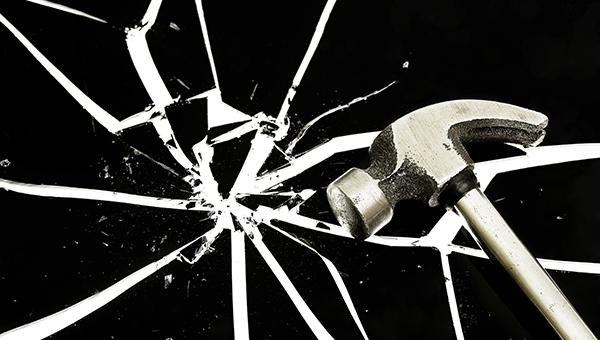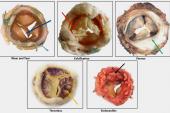Fracture Improves Gradients in ViV TAVI, but Ideal Timing Still Unknown
Bioprosthesis fracture might damage leaflets if it’s done post-TAVI, but doing it earlier might lead to hemodynamic instability.

To fracture or not to fracture—that has been the question dogging valve-in-valve (ViV) TAVI. The answer, new data suggest, is that fracturing the preexisting bioprosthetic aortic valve may be the best course of action for operators putting a transcatheter heart valve (THV) into a degenerated surgical aortic bioprosthesis.
In a “Key Abstract” released online this week as part of a sneak peek at TCT 2021, researchers report higher rates of procedural success and lower transvalvular mean gradients, both acutely and out to 1 year, if operators fractured the sewing ring of the preexisting surgical valve as part of the ViV TAVI procedure.
“We have favorable results acutely after bioprosthetic valve fracture and in continuity,” said lead investigator Christina Brinkmann, MD (Asklepios Klinik St. Georg, Hamburg, Germany), referring to the early and durable change in the transvalvular mean aortic gradient. Overall, fracturing the degenerated surgical valve during TAVI reduced the gradient by 6 mm Hg compared with a control group where the procedure was done without fracture, said Brinkmann.
Bioprosthetic valve fracture (BVF) is a technique performed to reduce the risk of high residual transvalvular gradients in ViV TAVI by cracking the ring of the preexisting surgical valve, which in turn allows operators to fully expand the new THV. There have been observational series showing the technique can reduce the transvalvular gradients and increase the valve effective orifice area, as well as others suggesting good outcomes out to 1 year. Still, Brinkman said data comparing ViV TAVI with BVF against procedures performed without fracture remains limited.
Alexandre Abizaid, MD, PhD (Institute Dante Pazzanese of Cardiology, Sao Paulo, Brazil), one of the session moderators, said that BVF is increasingly being performed at his center, as well as centers around the world, but there isn’t a lot of data to support the approach. David Rizik, MD (HonorHealth Medical Center, Scottsdale, AZ), one of panelists, praised the investigators for their research, particularly given the limited study of BVF for ViV TAVI.
“It’s nice to see science that adjudicates what your intellectual thinking is on this,” said Rizik, adding that most operators believe in the value of BVF, particularly after the THV is implanted.
More Than a Dozen International Centers
Researchers compared the acute and long-term outcomes of ViV TAVI with and without BVF in 160 patients across 14 international centers. All patients included in the study had degenerated surgical aortic valves—the most common were Mosaic (Medtronic), Mitroflow (Sorin Group USA), Perimount, and Magna (both Edwards Lifesciences)—with sewing rings that could be fractured or dilated with a high-pressure, noncompliant balloon during the TAVI procedure. The timing of the fracture was left to the operator’s discretion and a successful BVF was defined as a sudden drop in inflation pressure without balloon perforation and full expansion of the THV.
The two patient groups were well matched, although there were more men in the control group who didn’t undergo BVF during TAVI, which resulted in a larger aortic diameter and use of a larger surgical valve during the index procedure.
TAVI with BVF was successful in 93% of procedures, compared with a success rate of just 68% in cases where the THV was implanted without fracturing the preexisting surgical valve (P < 0.001). Prothesis failure, defined as a residual gradient of ≥ 20 mm Hg, was observed in 28% of procedures where the preexisting surgical valve was not fractured during TAVI as opposed to a failure rate of just 6% of BVF cases.
After valve-in-valve TAVI, the reduction in transvalvular mean gradient was larger in those treated with TAVI with BVF compared with cases without fracture (10.8 vs 15.8 mm Hg; P < 0.001). The difference in transvalvular gradient was maintained out to 1 year (12.4 vs 18.4 mm Hg; P < 0.001).
In terms of safety, one patient treated with TAVI plus fracture died in hospital, the result of an iliac artery perforation after balloon rupture, compared with two patients who died in the TAVI-without-fracture arm. There were two cases of ventricular septal rupture in the BVF group but no reported cases of aortic root rupture, stroke, coronary obstruction, or cardiac tamponade. One patient required a new pacemaker in the fracture arm compared with two patients in the TAVI-without-fracture group. Overall, there was no significant difference in any of the reported complications between groups.
In a linear mixed model, the researchers identified three predictors of a lower mean transvalvular gradient: employing bioprosthetic valve fracture, using a self-expanding valve (Evolut; Medtronic), and using any surgical aortic valve other than Mitroflow.
When to Fracture?
Abizaid said there are two schools of thought when it comes to the timing of BVF: before and after THV implantation. “When is the right time to do the fracture?” he asked. “Some do it before because they don’t want to damage the new valve leaflets, but then if you do it before there is a potential risk of acute aortic regurgitation and other complications. There are pros and cons for each [approach].”
Brinkmann said that while the timing of BVF was left to the operator’s discretion, nearly 90% of interventionalists fractured the preexisting surgical valve after the THV was implanted.
“We do this, too,” she said. “Of course, there is a risk of leaflet damage, but on the other hand, there are some practical reasons for doing this after [THV implantation]. If you implant the valve and you already have an acceptable gradient, then there is no use for BVF. You don’t have to do it every time. One of the risks of doing it before is that you can cause hemodynamic instability by causing acute regurgitation.”
Co-moderator Isaac George, MD (NewYork-Presbyterian/Columbia University Irving Medical Center, New York, NY), said their center fractures the preexisting surgical valve prior to THV implantation.
“I’ll strongly say that we do it beforehand,” he said. “I do think there is potentially some compromise for durability and leaflet dysfunction [with BVF after TAVI implantation]. It’s hard to imagine these leaflets don’t get damaged.” BVF after THV implantation might not make much difference to the 85-year-old patient, but if the patient is younger, there will be some concerns about how well the THV holds up in cases where the surgical valve is fractured with the THV in place. “If you’re trying to get more than 5 or 8 years out of a valve-in-valve, I’m still concerned we could compromise leaflet quality,” said George.
Brinkmann acknowledged that the timing of BVF is still a contested question, pointing out there are no long-term data to support either approach.
Michael O’Riordan is the Managing Editor for TCTMD. He completed his undergraduate degrees at Queen’s University in Kingston, ON, and…
Read Full BioSources
Brinkmann C, et al. Outcomes of valve-in-valve transcatheter aortic valve replacement with and without bioprosthetic valve fracture. Presented at: TCT 2021. October 6, 2021.
Disclosures
- Brinkmann reports no relevant conflicts of interest.





Comments